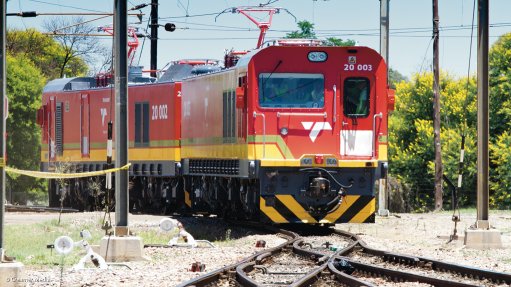First hot-rolled coil produced at Scaw’s new R5bn mill

This video, supplied by Scaw Metals, shows the first hot-rolled coil being produced at the new Germiston mill on November 11, 2024
The first hot-rolled coil (HRC) has been produced at Scaw Metals’ Union Junction complex in Ekurhuleni, heralding the reintroduction of competition into South Africa’s flat-steel market.
The R5-billion steel investment, which has been 75% funded by Absa and Investec and 25% funded by the State-owned Industrial Development Corporation, is also the first new flat-steel mill to be built domestically since Saldanha Steel in the 1990s, but which has since been mothballed.
The project will increase Scaw’s overall steelmaking capacity from about 500 000 t/y to 750 000 t/y once fully ramped up – a process that is expected to unfold over the coming 45 days.
Barnes Group CEO Doron Barnes – whose company acquired Scaw Metals, together with its Haggie and McKinnon Chain units, in May 2018 – tells Engineering News & Mining Weekly that the casting of the first coil on August 11 represents a milestone for the company and the country.
For Scaw, it adds HRC to the group’s primary steelmaking portfolio, which has hitherto consisted of only long-steel products.
As is the case with the long products produced by Scaw, the larger Barnes Group expects to absorb about half of the new mill’s output across its various downstream operations.
The balance will be sold to domestic customers that are currently mostly reliant on imported material for their tubing, shelving and re-rolling operations.
Based on state-of-the-art Danieli processing equipment, the Germiston plant will produce narrow- and medium-width HRC up to a metre, at gauges of between 1.2 mm and 6.0 mm.
Barnes estimates that the plant will replace about R4-billion-worth of narrow-gauge steel imports yearly.
For South Africa, meanwhile, Barnes believes the investment will help address the current domestic manufacturing imbalance between flat and long steel.
While significant long-product capacity is currently in place, there has been no flat-steel alternative to ArcelorMittal South Africa (AMSA) since the closure of Highveld Steel in 2016.
He also believes that the investment offers tangible evidence of the benefits that can flow as a result of government’s decision to place restrictions on scrap metal exports.
“I realise there is some negativity about the scrap export tax and the price preference system, but without these interventions we would struggle to access affordable material and there would be no advantage to manufacturing scrap-based steel in South Africa,” Barnes states.
Describing it as an industrial policy success story, Barnes admits to being concerned about current efforts by AMSA and others to have the scrap export trade restrictions overturned.
While acknowledging that the policy has placed pressure on AMSA’s Newcastle operation, he also points to the pricing differential that has emerged between long and flat products as a result.
Barnes attributes the dramatic improvement in prices for downstream consumers of long products to a combination of producer competition and a policy intervention that has offered mini-mills certainty of scrap supply at competitive prices.
He, thus, calls for ongoing policy certainty, which he believes could stimulate further investment, including by Scaw, which is considering a R1-billion investment into a new electric arc furnace.
Another advantage highlighted by Scaw’s Mzamo Mjekevu is the fact that the mill is producing flat and long steel that is regarded as “greener” than material being produced in blast furnaces.
This, owing to the lower carbon footprint associated with the electric-arc furnace process, where direct emissions can be near zero if the electricity is sourced from renewable energy, and the fact that “circularity” is embedded through the use of scrap.
The group is continuing to assess options for improving the green credentials of its steel even further by integrating renewable electricity into its process.
Given that such an activity would require a premium to be paid, Mjekevu says further greening steps will be taken only once there is firm customer demand.
Comments
Press Office
Announcements
What's On
Subscribe to improve your user experience...
Option 1 (equivalent of R125 a month):
Receive a weekly copy of Creamer Media's Engineering News & Mining Weekly magazine
(print copy for those in South Africa and e-magazine for those outside of South Africa)
Receive daily email newsletters
Access to full search results
Access archive of magazine back copies
Access to Projects in Progress
Access to ONE Research Report of your choice in PDF format
Option 2 (equivalent of R375 a month):
All benefits from Option 1
PLUS
Access to Creamer Media's Research Channel Africa for ALL Research Reports, in PDF format, on various industrial and mining sectors
including Electricity; Water; Energy Transition; Hydrogen; Roads, Rail and Ports; Coal; Gold; Platinum; Battery Metals; etc.
Already a subscriber?
Forgotten your password?
Receive weekly copy of Creamer Media's Engineering News & Mining Weekly magazine (print copy for those in South Africa and e-magazine for those outside of South Africa)
➕
Recieve daily email newsletters
➕
Access to full search results
➕
Access archive of magazine back copies
➕
Access to Projects in Progress
➕
Access to ONE Research Report of your choice in PDF format
RESEARCH CHANNEL AFRICA
R4500 (equivalent of R375 a month)
SUBSCRIBEAll benefits from Option 1
➕
Access to Creamer Media's Research Channel Africa for ALL Research Reports on various industrial and mining sectors, in PDF format, including on:
Electricity
➕
Water
➕
Energy Transition
➕
Hydrogen
➕
Roads, Rail and Ports
➕
Coal
➕
Gold
➕
Platinum
➕
Battery Metals
➕
etc.
Receive all benefits from Option 1 or Option 2 delivered to numerous people at your company
➕
Multiple User names and Passwords for simultaneous log-ins
➕
Intranet integration access to all in your organisation
















